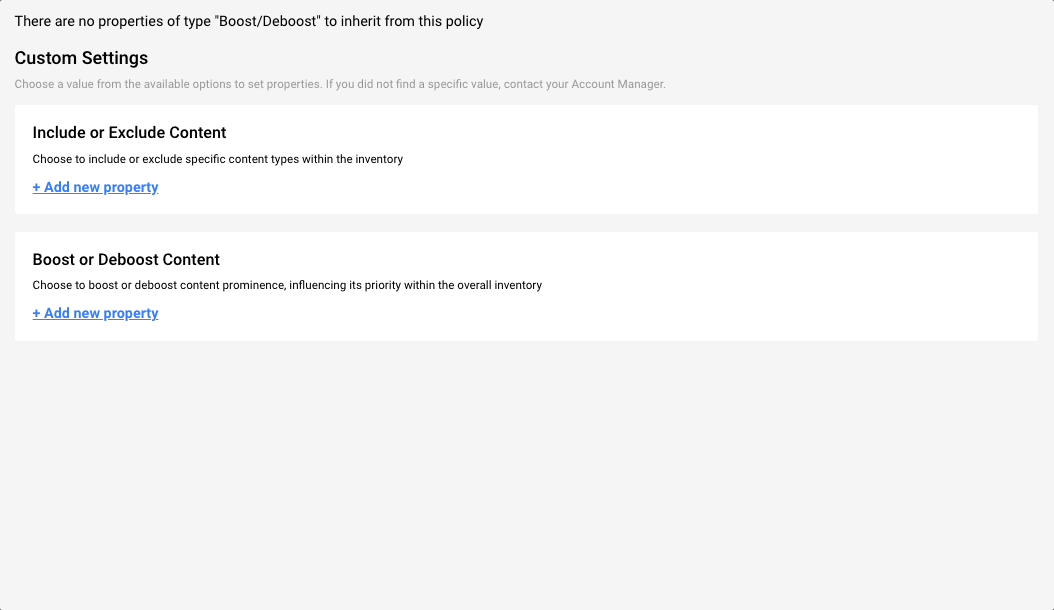Boost and Deboost in Policy Builder
Taboola’s Policy Builder also allows publishers to directly influence the recommendation algorithm to help better optimize toward specific outcomes. In this way, if a publisher has data that suggest content authored by its own staff and not by wire serves results in more subscription conversions, it could “Boost” the likelihood a staff article is recommended or “Deboost” the likelihood a wire service article by Reuters or the Associated Press is recommended in order to optimize for conversions. Think of “Deboostng” as “deemphasizing” and “Boosting” as “emphasizing” typed of content.
The Boost/Deboost feature has four options: Boost, Strong Boost, Deboost and Strong Deboost. They can be applied to any property mapped to create a recommendation inventory. Examples include categories (sports, news), authors, paywall settings and page typed.
In the animation below, a user will Strong Boost “Page Type: Text” and Deboost “Category: Farming”:

As powerful as this tool is, its use should be deliberate. Applying a Strong Deboost to “Category: Politics” will result in far fewer politics stories reaching users. At the same time, even though a user may show a sustained disinterest in a category like “Celebrity,” it doesn’t mean they will never see celebrity news. But that a “Category: Celebrity” article does have to have many other strong signals in its favor in order to be recommended to some users.
While there are dozens and dozens of factors involved in AI-based recommendations, a Boosted item would have around a 2X higher chance to be recommended and a Strong Boosted item 5X. A Deboosted item would be a 2X less chance to be recommended and a Strong Deboosted item 10X.
One extremely useful aspect for Deboost is to apply it to properties instead of using a hard policy exclusion. Generally, the largely the inventory the greater the personalization and performance. So, in the example above, rather than excluding all wire service content, by choosing to Deboost it, the publisher can allow important wire service articles to be eligible for recommendation, keeping more items in inventory. But, that Deboosted content has to be of higher-than-average interest or value to be recommended.
Other best practices:
• Start by NOT applying Boost/Deboosts and see what the algorithm chooses without adjustments. You might be positively surprised
• Before using Strong Boost or Strong Deboost always start with a standard Boost and Deboost. Perhaps that’s enough
• You can use this an an A/B test by running one variant without Boosting and Deboosting, and another variant with the desired Boost or Deboost. That way you’ll be able to know the tradeoff in performance. Reach out to your engagement manager if you’d like to run this as an A/B test
• Consider a Boost or Deboost only for specific user segments or day/time. Reach out to your engagement manager if you’d like to use segmented targeting
Boosts and Deboosts can stack, so that if “Page Type: Video” is boosted and “Category: Sports” is strong boosted, a sports video will be even more likely to be recommended. Boosts and Deboosts are can be inherited from higher level policies, like a Site Policy or a Network Master policy. In this way, these rules can be set and maintain across policies or sites.
After a user applies the desired Boost or Deboost, it’s critical to review the impact on the recommendable inventory. There will be error messages in the Policy Preview pane to the right to indicate if the Boost or Deboost is too broad or too narrow.
Possible error messages:
• “No effect on current inventory”
• “Extreme effect on current inventory”
For example, a Boost or Deboost that is applied to 100% of the inventory has no real impact since everything is affected. The same with a Boost or Deboost that applies to 0% of the inventory.
The inventory, however, is not static. A publisher’s recommendable inventory constantly changes in real time as new content is published. So a Boost applied to a specific columnist who publishes only twice a week, for example, may be a desirable outcome despite the “No effect on current inventory” warning occasionally displaying. It is simply in effect when content is found to match the rule.
But the “Extreme effect on current inventory” warning is a more significant issue to optimization and performance. If all or the vast majority of the content in a policy is Boosted or Deboosted, this is likely to be a regular occurrence and should be addressed.
Below are examples of the warnings in the Preview Panel:

